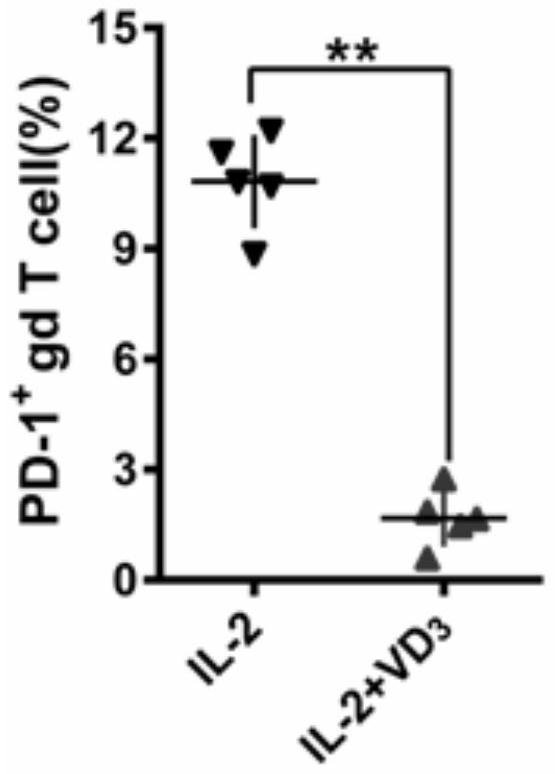Vitamin D3 or its active form 1α,25(oh) 2 d 3 Application in inhibiting the expression of PD-1
A technology of PD-1 and vitamins, applied in the field of biomedicine, can solve the problems of not finding screening methods, affecting the effect of PD-1 antibodies, and large toxic and side effects, and achieve good tolerance, enhanced function, and no toxic and side effects.
- Summary
- Abstract
- Description
- Claims
- Application Information
AI Technical Summary
Problems solved by technology
Method used
Image
Examples
Embodiment 1
[0050] 1α,25(OH) 2 D. 3 (Calcitriol) has the following structural formula:
[0051]
[0052] The above compounds are used as PD-1 inhibitors. This compound is commercially available from Sigma Corporation.
Embodiment 2
[0053] Example 2: Expansion of Vγ9Vδ2 T cells
[0054] The normal human blood buffy coat was separated from the Guangzhou Blood Bank Center. The separation solution (ficoll) was purchased from GE Healthcare, and the gradient centrifugation (600g, 30min, centrifugation conditions: up to 6 down to 2), and the obtained peripheral blood mononuclear cells were selected Sexual expansion culture (culture conditions: on the 0th day, Zol phosphoric acid (Zol, purchased from Sigma Company) 30-50 (μM), the concentration used in this implementation is 40 (μM), recombinant human interleukin 2 (IL-2), 40ng / mL, 1α,25(OH) 2 D. 3 The addition amount is 50 (nmol / L); on the third day, the culture medium is changed without adding Zol, and the recombinant human interleukin 2 is changed to 10ng / mL, 1α,25(OH) 2 D. 3 The amount added was 50 (nmol / L); the ratio of Vγ9Vδ2 / CD3 was detected by flow cytometry on the 12th day. The result is as figure 1 As shown, the results showed that Vγ9Vδ2 T cells ...
Embodiment 3
[0055] Example 3: Protein lysis (RIPA) was performed on the Vγ9Vδ2T cells in Example 2, and 20ug was used for protein gel electrophoresis to detect the protein level of PD-1, and actin was used as an internal reference. The result is as figure 2 As shown, the results show that 1α,25(OH) 2 D. 3 It has a good inhibitory effect on PD-1 of Vγ9Vδ2T cells.
PUM
 Login to View More
Login to View More Abstract
Description
Claims
Application Information
 Login to View More
Login to View More - R&D Engineer
- R&D Manager
- IP Professional
- Industry Leading Data Capabilities
- Powerful AI technology
- Patent DNA Extraction
Browse by: Latest US Patents, China's latest patents, Technical Efficacy Thesaurus, Application Domain, Technology Topic, Popular Technical Reports.
© 2024 PatSnap. All rights reserved.Legal|Privacy policy|Modern Slavery Act Transparency Statement|Sitemap|About US| Contact US: help@patsnap.com










